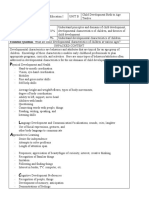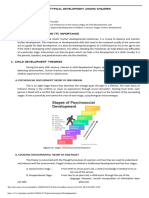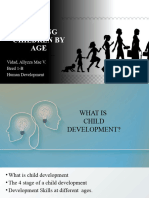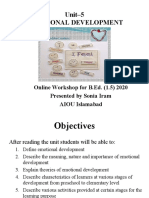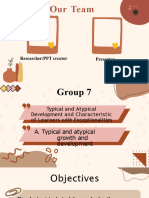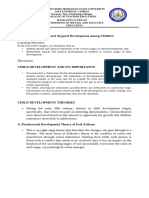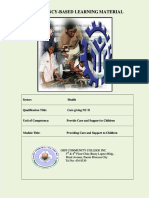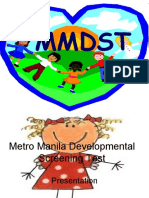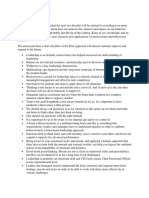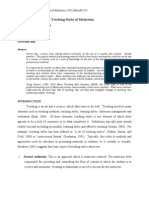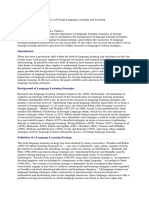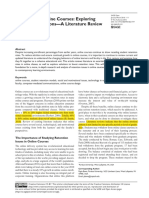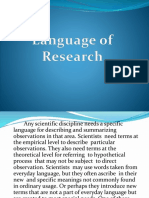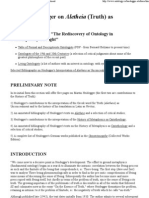0 ratings0% found this document useful (0 votes)
34 viewsEssential Question
Essential Question
Uploaded by
api-404593823This document discusses developmental characteristics of children from birth to age 12 across six domains of development:
1. Physical development - Includes milestones like hand-eye coordination, mobility, and fine/gross motor skill development.
2. Language development - Focuses on vocalizations, gestures, and emerging reading/writing/speaking abilities.
3. Cognitive development - Covers areas like problem-solving, attention span, recognition of people/things, and memory/anticipation.
4. Emotional development - Discusses reactions to positive/negative factors, ability to self-calm, and emerging fears.
5. Social development - Looks at signs of social contact desire, trust-
Copyright:
© All Rights Reserved
Available Formats
Download as PDF, TXT or read online from Scribd
Essential Question
Essential Question
Uploaded by
api-4045938230 ratings0% found this document useful (0 votes)
34 views2 pagesThis document discusses developmental characteristics of children from birth to age 12 across six domains of development:
1. Physical development - Includes milestones like hand-eye coordination, mobility, and fine/gross motor skill development.
2. Language development - Focuses on vocalizations, gestures, and emerging reading/writing/speaking abilities.
3. Cognitive development - Covers areas like problem-solving, attention span, recognition of people/things, and memory/anticipation.
4. Emotional development - Discusses reactions to positive/negative factors, ability to self-calm, and emerging fears.
5. Social development - Looks at signs of social contact desire, trust-
Original Title
4
Copyright
© © All Rights Reserved
Available Formats
PDF, TXT or read online from Scribd
Share this document
Did you find this document useful?
Is this content inappropriate?
This document discusses developmental characteristics of children from birth to age 12 across six domains of development:
1. Physical development - Includes milestones like hand-eye coordination, mobility, and fine/gross motor skill development.
2. Language development - Focuses on vocalizations, gestures, and emerging reading/writing/speaking abilities.
3. Cognitive development - Covers areas like problem-solving, attention span, recognition of people/things, and memory/anticipation.
4. Emotional development - Discusses reactions to positive/negative factors, ability to self-calm, and emerging fears.
5. Social development - Looks at signs of social contact desire, trust-
Copyright:
© All Rights Reserved
Available Formats
Download as PDF, TXT or read online from Scribd
Download as pdf or txt
0 ratings0% found this document useful (0 votes)
34 views2 pagesEssential Question
Essential Question
Uploaded by
api-404593823This document discusses developmental characteristics of children from birth to age 12 across six domains of development:
1. Physical development - Includes milestones like hand-eye coordination, mobility, and fine/gross motor skill development.
2. Language development - Focuses on vocalizations, gestures, and emerging reading/writing/speaking abilities.
3. Cognitive development - Covers areas like problem-solving, attention span, recognition of people/things, and memory/anticipation.
4. Emotional development - Discusses reactions to positive/negative factors, ability to self-calm, and emerging fears.
5. Social development - Looks at signs of social contact desire, trust-
Copyright:
© All Rights Reserved
Available Formats
Download as PDF, TXT or read online from Scribd
Download as pdf or txt
You are on page 1of 2
Child Development Birth to Age
COURSE: Early Childhood Education I UNIT B
Twelve
Understand principles and domains of child development,
COMPETENCY: 4.00 B2 21% developmental characteristics of children, and theories of
child development.
OBJECTIVE: 4.02 B2 7% Understand developmental characteristics of children.
Essential Question: What are some developmental characteristics of children at various ages?
UNPACKED CONTENT
Developmental characteristics are behaviors and attributes that are typical for an age group of
children. Knowledge of these characteristics enables early childhood professionals to plan
appropriate programs, curricula, and activities. Here are some types of behaviors/attributes often
addressed in developmental characteristics for the six domains of child development.
Physical Development and Health
∙ Hand-to-mouth coordination
∙ Vision, eye-hand coordination
∙ Mobility
∙ Fine and gross motor skills
∙ Self-help skills
∙ Average height and weightReflexes, types of body movements,
degree of body coordination
∙ Ability to lift, support, move head
∙ Abilities with hands
∙ Questioning
∙ Connecting words with people, things
∙ Reading, writing, speaking, and
listening skills
∙ Language Development and CommunicationVocalizations, sounds, cries, laughter
∙ Use of facial expressions, gestures, and
other body language to communicate
Approaches to Learning
∙ Desire for independence
∙ Attempts to solve problems
∙ Length of attention span
∙ Responses; appreciation of beautySigns of curiosity, interest, creative thinking
∙ Recognition of familiar things
∙ Imitation
∙ Following and finding things
∙ Interest in books, TV, computer, etc.
∙ Cognitive Development Preferences
∙ Recognition of people, things
∙ Development of memory; anticipation
∙ Demonstrations of feelings
∙ Emerging fears
∙ Emotional DevelopmentReactions to positive and negative factors
∙ Ability to calm oneself, manage feelings
Social Development
∙ Evidence of desire for social contact
∙ Evidence of trust; search for approval
∙ Testing limits
∙ Understanding of self in relation to othersStyles of play, interactions with others
∙ Signs of concern, affection
You might also like
- Assignment 2 - EDE3263-Becoming An Early Childhood ProfessionalDocument15 pagesAssignment 2 - EDE3263-Becoming An Early Childhood ProfessionalKidstime100% (1)
- MMDST (Preschooler)Document58 pagesMMDST (Preschooler)kanotlabhoneyNo ratings yet
- C5 Typical and Atypical DevelopmentDocument5 pagesC5 Typical and Atypical DevelopmentMary Ann Bandola100% (4)
- Week 6 - Communicating With ChildrenDocument64 pagesWeek 6 - Communicating With ChildrenMuhammad Arsyad SubuNo ratings yet
- Essential QuestionDocument2 pagesEssential Questionapi-404592166No ratings yet
- Essential QuestionDocument2 pagesEssential Questionapi-404592054No ratings yet
- Essential QuestionDocument2 pagesEssential Questionapi-404592009No ratings yet
- Essential QuestionDocument2 pagesEssential Questionapi-407210229No ratings yet
- Essential QuestionDocument2 pagesEssential Questionapi-408365140No ratings yet
- Essential QuestionDocument2 pagesEssential Questionapi-404551191No ratings yet
- 4 02 Notes WeeblyDocument1 page4 02 Notes Weeblyapi-316587310No ratings yet
- Typical and Atypical... Ildren 1Document20 pagesTypical and Atypical... Ildren 1maryjanemagtanaoNo ratings yet
- CHAPTER 5 Typical and Atypical Development Among ChildrenDocument13 pagesCHAPTER 5 Typical and Atypical Development Among ChildrenDIMPZ MAGBANUANo ratings yet
- 4 01 Notes WeeblyDocument2 pages4 01 Notes Weeblyapi-316565043No ratings yet
- Sped Finals ReviewerDocument10 pagesSped Finals ReviewerhaninamacapantonNo ratings yet
- 4 03notesweeblyDocument2 pages4 03notesweeblyapi-356809003No ratings yet
- ECED-115 mid to finalDocument14 pagesECED-115 mid to finalFherry AlarcioNo ratings yet
- hpcDocument7 pageshpcsharmaridima009No ratings yet
- PEC-301-Ppt-Lesson5 Group1 and Group2 2Document71 pagesPEC-301-Ppt-Lesson5 Group1 and Group2 2Mary Ann Bandola100% (1)
- Early ChildhoodDocument21 pagesEarly ChildhoodsamridhiaroraNo ratings yet
- PROFED8_REVIEWERFSIEDocument22 pagesPROFED8_REVIEWERFSIElynette montablanNo ratings yet
- Eyfs Cards 0001207Document48 pagesEyfs Cards 0001207Bedsa100% (2)
- Chap5 Typical and Atypical DevelopmentDocument5 pagesChap5 Typical and Atypical DevelopmentCheyNo ratings yet
- Defining Children by AgeDocument19 pagesDefining Children by AgeAllyzza Mae VidadNo ratings yet
- Ppo 1Document3 pagesPpo 1api-250718830No ratings yet
- Unit-5 Emotional Development: Online Workshop For B.Ed. (1.5) 2020 Presented by Sonia Iram AIOU IslamabadDocument20 pagesUnit-5 Emotional Development: Online Workshop For B.Ed. (1.5) 2020 Presented by Sonia Iram AIOU IslamabadYahya RajputNo ratings yet
- SPED 100 ReportDocument17 pagesSPED 100 ReportKristel SalmoroNo ratings yet
- CHAPTER 5 PED 107Document7 pagesCHAPTER 5 PED 107Danny Kim PigarNo ratings yet
- Self-Regulation Assessment ScaleDocument2 pagesSelf-Regulation Assessment Scaleapi-383607481100% (2)
- Growth and developmentDocument53 pagesGrowth and developmentandrewcudiamatfaqNo ratings yet
- Provide Care and Support To ChildrenDocument116 pagesProvide Care and Support To Childrenbing mastur100% (1)
- Childhood DevelopmentDocument5 pagesChildhood DevelopmentAlan RagiNo ratings yet
- Essential QuestionsDocument4 pagesEssential Questionsapi-356809003No ratings yet
- FS-1-REVIEWERDocument6 pagesFS-1-REVIEWERCherry Mae BedoyaNo ratings yet
- Course-Module - Educ 1 Week 12Document9 pagesCourse-Module - Educ 1 Week 12DarcknyPusodNo ratings yet
- Typical & Atypical DevelopmentDocument33 pagesTypical & Atypical DevelopmentMico JohnNo ratings yet
- MMDST PreschoolerDocument58 pagesMMDST PreschoolerGerard Paul Oriza100% (2)
- Reading - Chapter 5Document37 pagesReading - Chapter 5xkmzrsdnbcNo ratings yet
- Module 4 Birth and Development of Children PDFDocument15 pagesModule 4 Birth and Development of Children PDFKevin PajarilloNo ratings yet
- Unit-5 060607Document4 pagesUnit-5 060607John Mark AlagonNo ratings yet
- Module 1 Prof - Ed. CAL For B - ToopyDocument39 pagesModule 1 Prof - Ed. CAL For B - ToopymaluyamarknoliNo ratings yet
- Typical and Atypical Development Among ChildrenDocument15 pagesTypical and Atypical Development Among ChildrenJohn guyll AtilanoNo ratings yet
- K1 PDFDocument11 pagesK1 PDFHoney PatelNo ratings yet
- Ea 3201 EcdeDocument3 pagesEa 3201 EcdeRiaz UddinNo ratings yet
- Stages of DevelopmentDocument23 pagesStages of DevelopmentJanny DiezNo ratings yet
- Funda1 The Child Module 1st Sem - FSDocument70 pagesFunda1 The Child Module 1st Sem - FSHidin KasanNo ratings yet
- Universally Speaking: The Ages and Stages of Children's Communication Development From 5 To 11 YearsDocument28 pagesUniversally Speaking: The Ages and Stages of Children's Communication Development From 5 To 11 Yearstransicion videosNo ratings yet
- Introduction To Childhood Development: by Pranjali JoshiDocument6 pagesIntroduction To Childhood Development: by Pranjali Joshipranjali joshiNo ratings yet
- Facilitating Learner-Centered Teaching FinalDocument158 pagesFacilitating Learner-Centered Teaching FinalGeroy ConcepcionNo ratings yet
- How Do Children Grow Develop and LearnDocument49 pagesHow Do Children Grow Develop and LearnRona BrusasNo ratings yet
- Foundations of Early Childhood Principles and Prac... - (CHAPTER 5 HOW CHILDREN DEVELOP)Document20 pagesFoundations of Early Childhood Principles and Prac... - (CHAPTER 5 HOW CHILDREN DEVELOP)Nguyễn DungNo ratings yet
- Personal Development Q1 Week 3Document2 pagesPersonal Development Q1 Week 3Jean DaclesNo ratings yet
- Health Teaching For Development MilestonesDocument9 pagesHealth Teaching For Development MilestonesZen PingawanNo ratings yet
- 5-Identify The Elements of A Developmentally Appropriate EnvironmentDocument3 pages5-Identify The Elements of A Developmentally Appropriate Environmentapi-295870335100% (1)
- EFN 4201 Lecture Week 6Document36 pagesEFN 4201 Lecture Week 6mr177463No ratings yet
- Early Years FoundationDocument24 pagesEarly Years FoundationbojvicNo ratings yet
- EYFS Principles Into Practice CardsDocument37 pagesEYFS Principles Into Practice CardsMsHong BgsNo ratings yet
- the four before: A Resource · A Reference · A Refresher For Instructional StakeholdersFrom Everandthe four before: A Resource · A Reference · A Refresher For Instructional StakeholdersNo ratings yet
- Understanding Toddler Development: Understanding Toddlers, #1From EverandUnderstanding Toddler Development: Understanding Toddlers, #1No ratings yet
- Omari Perez - Observation KWL 1Document1 pageOmari Perez - Observation KWL 1api-404593823No ratings yet
- Omari Perez - Thursday April 26Document10 pagesOmari Perez - Thursday April 26api-404593823No ratings yet
- Omari Perez - 6Document1 pageOmari Perez - 6api-404593823No ratings yet
- Observing Children ArticleDocument4 pagesObserving Children Articleapi-404593823No ratings yet
- Sow A Thought, and You Reap An Act Sow An Act, and You Reap A Habit Sow A Habit, and You Reap A Character Sow A Character, and You Reap A DestinyDocument1 pageSow A Thought, and You Reap An Act Sow An Act, and You Reap A Habit Sow A Habit, and You Reap A Character Sow A Character, and You Reap A Destinyapi-404593823No ratings yet
- Rubric SSR Writing AssignmentDocument1 pageRubric SSR Writing Assignmentapi-296621128No ratings yet
- Burlington International English B1 Unit 4 Time For School!Document1 pageBurlington International English B1 Unit 4 Time For School!Elena Gutierrez100% (2)
- Salkovskis Undesrstanding and Treating OCD 1999 PDFDocument24 pagesSalkovskis Undesrstanding and Treating OCD 1999 PDFMannymorNo ratings yet
- NeuroscienceDocument2 pagesNeuroscienceHina HussainNo ratings yet
- Contrastive AnlysisDocument30 pagesContrastive AnlysisIsburt82% (17)
- NeuroTracker - Cercetari SportiveDocument29 pagesNeuroTracker - Cercetari SportiveBogdan GheorghiuNo ratings yet
- Know Yourself: Music Teaching Styles of Malaysian School Music TeachersDocument11 pagesKnow Yourself: Music Teaching Styles of Malaysian School Music TeachersSuhaimi ShoibNo ratings yet
- Thoren 4-6-2016 LessonplanDocument5 pagesThoren 4-6-2016 Lessonplanapi-296695540No ratings yet
- Key Points of Syllabus Design Master Two Biskra UniversityDocument14 pagesKey Points of Syllabus Design Master Two Biskra UniversityImī LīnäNo ratings yet
- Audio-Lingual MethodDocument19 pagesAudio-Lingual MethodSoon Huong SiaNo ratings yet
- Lev VygotskyDocument10 pagesLev Vygotskyimane nour100% (2)
- Red TeamingDocument100 pagesRed TeamingbmurilloNo ratings yet
- OB12 06inDocument37 pagesOB12 06inRahul SinghNo ratings yet
- Classroom Management (Aufa)Document2 pagesClassroom Management (Aufa)IhsanNashiNo ratings yet
- Long Lesson Plan 1 Unit 1 - Education at SchoolDocument7 pagesLong Lesson Plan 1 Unit 1 - Education at Schoolapi-269506025No ratings yet
- Language Learning Strategies in Foreign Language Learning and TeachingDocument12 pagesLanguage Learning Strategies in Foreign Language Learning and TeachingMarivic Daludado BaligodNo ratings yet
- The 12 Lessons of Psycho-Cybernetics - James-Simon M. SchmidtDocument6 pagesThe 12 Lessons of Psycho-Cybernetics - James-Simon M. Schmidtkaya nath100% (6)
- INTERSUBJECTIVITYDocument10 pagesINTERSUBJECTIVITYMiles Dela CruzNo ratings yet
- IAT201.Review Fall2019.KeyDocument81 pagesIAT201.Review Fall2019.KeyJin Tao WangNo ratings yet
- Introduction To Cognitive Science 4Document3 pagesIntroduction To Cognitive Science 4via macarioNo ratings yet
- Retention in Online Courses - Exploring Issues and SolutionsDocument11 pagesRetention in Online Courses - Exploring Issues and SolutionsEli RomeroNo ratings yet
- Instructional StrategiesDocument48 pagesInstructional Strategiesapi-31370746350% (2)
- 5 Ritual Form HypothesisDocument4 pages5 Ritual Form HypothesisMaria Antonietta RicciNo ratings yet
- Abel Hirsch2016Document11 pagesAbel Hirsch2016albertoadalidNo ratings yet
- Psychology Essay Questions 1Document9 pagesPsychology Essay Questions 1keyas143No ratings yet
- Language of ResearchDocument8 pagesLanguage of Researchangie gayomaliNo ratings yet
- Heidegger AletheiaDocument8 pagesHeidegger AletheiaAnemona Ciupitu100% (1)
- Exploring The Relationship Between Iranian EFL Learners' Multiple Intelligences, Locus of Control and Reading ProficiencyDocument20 pagesExploring The Relationship Between Iranian EFL Learners' Multiple Intelligences, Locus of Control and Reading Proficiencymuhammad eslamiNo ratings yet
- Dreams and Projections From Seth Early SessionsDocument169 pagesDreams and Projections From Seth Early SessionsPT100% (1)
- Socratic QuestionsDocument5 pagesSocratic Questionss s madhavNo ratings yet








